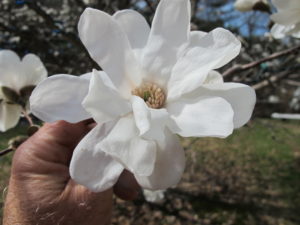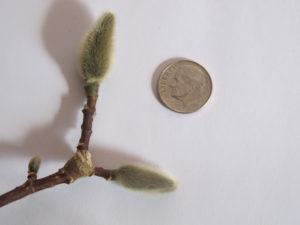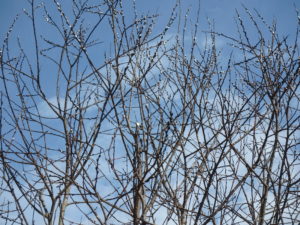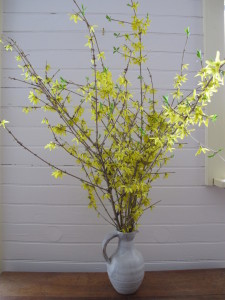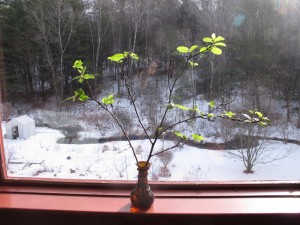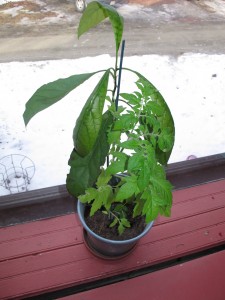Forcing Flowers of Shrubs and Trees
When I was in first grade we learned a song about pussy willows that still rings in my head when I walk past the fire pond in Cornish Flat. Or it did recently when I saw pussy willows starting to pop open in a marshy area. Spring is here.
Pussy willows are actually the flowers of a wild shrub or small tree, the goat or pussy willow, also known by its scientific name, Salix caprea. This willow is a native to the United States and grows best in moist or soggy soils, or even in standing water. Full sun is best, but it can grow in part sun. It will grow up to 25 feet tall, but 15 feet is more common. The flowers grow on the top of the plant, so I use a pole pruner to get the branches I want.
Another willow, Salix discolor, is also a pussy willows but is “susceptible to a canker and is considered inferior for landscape use, though neither species is a plant of the first order.” That according to Michael Dirr in his book Manual of Woody Landscape Plants which I consider my bible of trees and shrubs.
He is right about pussy willows not being plants of the first order. Their time of glory is the spring, when the catkins or blossoms appear. The rest of the year it is a relatively unkempt, messy plant that spreads and is often too large to be considered a shrub, but not big enough to be considered a tree. The stems are weak, sometimes flopping over and easily breaking in ice storms. Still, if you have a wet area on your property, and like fat, fuzzy pussy willows in the spring, you should have some.
When I picked some pussy willow stems recently, I put them in a vase with water. This will encourage un-opened buds to open. Later, when all the blossoms are fully open, I will pour out the water and allow the stems to remain in a dry vase. This will prevent them from producing yellow pollen (which will fall on the table top) and allow me to have the fuzzies forever, or at as long as I want. One year, inadvertently, I kept a vase of pussy willows for a full year, and they still looked good!
Another plant that can be forced to flower now looks similar to pussy willows at a quick look. I have a tree covered with fuzzy buds that are actually unopened flower buds that look like the pussy willow flowers. The hybrid magnolia ‘Merrill’ has these buds all winter, but when put in water now the buds will produce large white blossoms. Other magnolias have similar buds – like pussy willows on steroids.
The Merrill magnolia will generally bloom for me in late April. The closer to the date of outdoor blooming, the quicker buds will open in a vase indoors. I once did some pruning in December and forced magnolia buds indoors, but it took over a month for that to happen. Now it should happen in half that time (though pussy willow buds will open in just a few days).
My Merrill magnolia is one of my favorite trees. Mine is about 20 or 25 years old, and is roughly 30 feet tall with a 20 foot spread. When it blooms the flowers are bountiful – a thousand, perhaps – and magnificent. Each blossom is about 3 inches across and lightly fragrant. I recommend them as specimen trees in the middle of a lawn or field in full sun.
Another classic early spring shrub is forsythia. Like the daffodil, this early bloomer is bright yellow, a color I have come to associate with spring. It can be used as a hedge, or pruned into a vase-shaped shrub that stays relatively small, say 8 feet tall and 6 feet wide.
To get forsythia to bloom, pick stems that are more than one year old. New stems are generally straight, with few side branches and even fewer buds. The buds on new branches tend to be leaf buds. Older branches will be branched, and loaded with flower buds. And for best results, don’t forget to change the water in the vase every 2 or 3 days.
Forsythia is a nice enough plant, but like pussy willows, it is not my favorite. It is rambunctious, for starters. It wants to take over the world, sending out roots that then send up new plants. My neighbor planted a forsythia hedge, and now I have forsythia that has encroached onto my land. Fortunately, it is easy enough to control if you pull out new shoots early on. Or failing that, cut them back every year.
As a child, however, I loved forsythia. My gardening grandfather planted a double row of them between the house and the vegetable garden. As the plants grew and spread they became a dense thicket perhaps 40 feet long, 10 feet wide and 10 feet tall. My sister Ruth Anne and I discovered that if we crawled into this thicket there was a hidden ”room” in the middle where we could hide from adults on hot summer days.
Apple blossoms are great for forcing, too. When I prune in March I take branches with short fruit spurs, put them in a vase, and get flowers. At this time of year, one can’t have too many blossoms!
Read Henry’s twice-weekly blog at https://dailyuv.com/
Mid-Winter Blahs
I’ve been hearing from friends who are sick of winter. We’re only about half way done with it, but we haven’t had a break – no January thaw this year – and the snow keeps building up. I’ll have to admit that I’m a little tired of shoveling and paying to get my roof cleared. So what can a gardener do? There’s plenty.
First, plant something. Nothing makes us gardeners feel better than planting (unless it’s picking peonies, which we can’t do yet). One of my favorite tricks is to sprinkle poppy seeds on the snow above a flower bed. These seeds are tiny and black, and the sun heats them enough to melt through the snow in the course of the winter. And although the germination rate will be low, I save seeds and have plenty. So it doesn’t matter if only a few find a nice crack in the soil and grow, come summer.
This weekend I will dig out my potting soil and trays and plant some onion seeds indoors. Onions take a long time to grow, so I like to start seeds in February, or early March at the latest. For a long time I just planted onion sets – dry, diminutive onions that are sold to start new onions. But then I learned that one can buy – or start from seed and then transplant – small green onion plants. I find that these plants are more vigorous.
If you don’t want to go through the trouble of raising your own onion plants, some seed catalogs will sell the plants at the appropriate time – but those are a lot more expensive than doing your own from seed.
And it’s not too early to cut branches for forcing. I have cut forsythia and magnolia branches, and will make a trip on my snowshoes to the wetland where pussywillows grow. All three – and others, like quince and apple – can be made to bloom inside the house. Just cut stems and put them in a vase with water.
Forsythia is, in my view, an old fashioned plant. My grandfather had a huge patch of forsythia growing as an island in the lawn. It separated his old 1860’s farmhouse from the vegetable garden. They grew tall and dense. I don’t know if he planted them when he bought the place in the 1920’s, or if they were already there. I suspect he planted them.
There must have been a dozen forsythia plants or so, planted in a double row about 10 feet apart. By the time I came along they created a secret hiding place in the middle between the two rows. My sister and I would crawl into the interior of the patch and we were totally hidden from adult view. A fine hiding place it was.
Grampy lived in Spencer, Massachusetts where winter temperatures probably never went much below zero. But living in the cold north, where we see minus 10 to 25 degrees for night after night, means that when I bought my place in 1970, forsythia was not a good option. Yes, it would survive, but the flower buds would be killed by cold temperatures unless buried by snow. I know, I tried.
Hybridizers kept trying different crosses – hybrids- and finally developed plants good for Zone 4 (with temps as low as minus 30). The late plantsman Paul Joly (here in Cornish, NH) developed one variety, ‘New Hampshire Gold’. Other good ones include ‘Meadowlark’, ‘Vermont Sun’ and ‘Northern Gold’. All those were created just with old fashioned breeding techniques, no genetic engineering.
I love cutting magnolia stems for forcing, even though it takes a long time to get the blossoms to open. I love them because the buds are fuzzy and big, sort of like pussywillows on steroids. I have a mature Merrill magnolia that is my favorite tree. It blooms every year on my birthday in late April, it has green glossy leaves all summer, and it has fabulous fuzzy flower buds that I can look at (and that make me smile) all winter. Fabulous plant. If I were sentenced to live in exile on an island and could bring just one tree, it might well be a magnolia (though an apple tree would be in strong competition).
I usually wait until late March to cut apple branches for forcing because that is when I start pruning apple trees. If you want the stems to bloom, you need to pick mature branches, not those young whips called water sprouts. Those straight stems look great in a vase, but will only produce leaves. To get blossoms, you must have fruit spurs, which are 3 to 6 inch branches – spurs – attached to old wood. You will notice fruit buds, which are larger than leaf buds, near the tip of fruit spurs. These will produce a cluster of blossoms, and leaves, too.
Meanwhile, we should all be thankful for all the snow we’ve had. It protects our perennials, the tender ones, from severe temperatures. I once dug down through 4 feet of fluffy snow and probed the soil in my vegetable garden with a thermometer. Just a couple of inches down the soil was 37 degrees. And only the top inch or so was even frozen. Barren winters, with no snow, are much harder on our plants, even if not so cold as this year.
So bundle up, put on your earmuffs and scarf, and go cut some stems and put them in water. Before too long, you’ll have spring in your house – even if it’s still snowing outside.
Henry Homeyer lives in Cornish Flat, NH. He is the author of 4 gardening books and a children’s fantasy-adventure about a boy and a cougar called Wobar and the Quest for the Magic Calumet. His web site is www.Gardening-Guy.com.
Getting through the Doldrums
When pruning a Merrill magnolia last November, I brought home a few stems that had nice fat flower buds and put them in a vase of water. I put them in a south-facing window and pretty much forgot about them. From time to time I admired the smooth gray bark and handsome branching patterns. But then in the first week of January, those stems developed lovely green leaves! And the flower buds are swelling and look as if they might bloom, too – but even if they don’t, my spirits are lifted by seeing some green leaves.
Forcing blossoms of tree branches (making them bloom early indoors) is normally something I do in March, when I am pruning apple trees. I always bring in some branches and enjoy both the leaves and flowers of stems I have cut. At that time of year the trees are already “thinking” about opening up their buds, and it only takes a week or two for them to open up on a sunny windowsill.
But this year, I am going to cut apples, forsythia, lilacs and other spring-blooming trees and shrubs starting now. Each week I shall snip a few branches and experiment with forcing. I have never tried forcing lilacs, for example, and since they are mid-to late-spring bloomers, I would normally hold off until nearer the time that they normally break dormancy –perhaps in April. But why not try now? I have read that one can encourage branches to break dormancy by submerging them entirely in a bathtub of water and will give that a try.
When you select branches for forcing, be sure to pick some that have flower buds. Flower buds are generally fatter than leaf buds. On apple trees, flowers are generally found on fruit spurs. These are 2- or 3-inch long stems that end in fat buds. The buds contain both leaf and flower buds. For many varieties, fruit spurs must be more than a year old in order to produce flowers (and hence fruit). Last year’s water sprouts (vertical whips) on apples will produce leaves but not flowers.
Almost any tree can be forced, but many do not have flowers that are colorful, so we often ignore them. Do you know what a maple or poplar blossom looks like? Their small green flowers are not much appreciated – and I have never cut them to put in a vase. You certainly recognize pussy willows as signs of spring, but do you think of those furry fellows as flowers? They are flowers, and can give me as much pleasure in February as my roses will later on.
For best results, cut stems of trees according to their natural schedule. That means picking early bloomers now, and later bloomers in February and March. Here is a rough schedule: In January cut forsythia , willows and poplars. In early February cut red maples, alder, quince, birch and cherries. Later in February try rhododendrons, azaleas and pussy willows. Then in March try cutting branches of hawthorns, shrub honeysuckles, apples, crabapples, mockorange, lilacs, and spirea.
Elsewhere in the house I was recently surprised by a tomato plant that appeared in a pot where I have an avocado growing. The avocado was one that I dug out of the compost pile last fall – along with a tomato seed, apparently. Most grocery store avocados do not have viable seeds, as the seeds need to be fresh (picked within 3 weeks of planting) in order to grow.
I remember as a boy suspending an avocado seed in a glass of water by toothpicks. It sent roots down into the glass, and then sent up a stem. I planted the seedling in a pot, creating a nice houseplant with glossy green leaves. But since the avocado industry now stores and sells avocados all year, the seeds are usually too old to grow. But I guess last summer I threw a few fresh avocado seeds into the compost because three seeds grew!
But what about that orphan tomato growing with my avocado? I am going to give it every benefit. I have heard about people who have gotten tomatoes to bloom and produce fruit indoors in winter, though I have never done it. To help mine along I have hung a light over it in the window where it is growing. I am using an LED light that uses very little energy and produces a lot of light from its 45 little LED bulbs. It’s produced by Sunshine Systems (www.sunshine-systems.com) and uses just 28 watts of power while providing the light of a 250 watt hps lamp.
I realize that my tomato might not produce tasty fruit even if I get some. It all depends on the seed: it will be fine if it came from an heirloom tomato (which is mostly what I grow), but if it’s from a hybrid tomato plant, it might produce an undesirable fruit. Hybrids most often revert to the parent types, which may not be tasty. Still … it’s winter, and I’m game to try almost anything to feel like a gardener.
Henry Homeyer is the author of 4 gardening books and lectures on gardening throughout New England. He can be reached at henry.homeyer@comcast.net.



